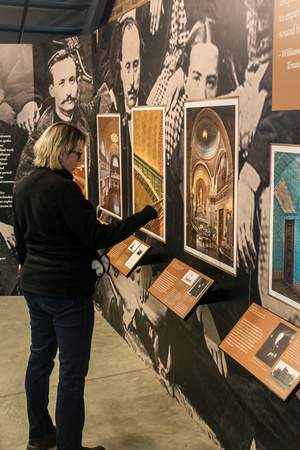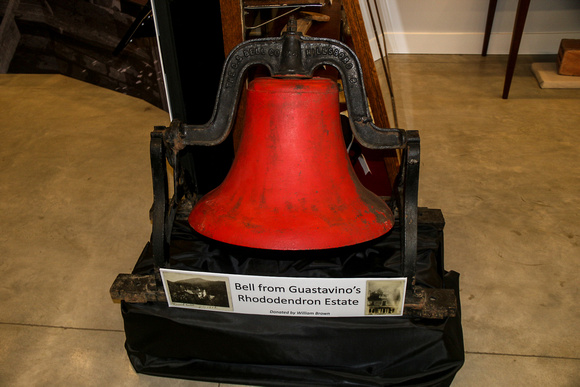Palaces for the People: Guastavino & America’s Great Public Spaces
Take the self-guided tour of Guastavino’s projects in Asheville and Black Mountain. Download the guide here.
From 1882 to 1943, in 31 states and 6 countries, Rafael Guastavino and his son created more than 600 unique tile domes and vaultings that met his criteria of health, safety, and beauty.
PALACES FOR THE PEOPLE: GUASTAVINO AND AMERICA’S GREAT PUBLIC SPACES is an exhibition about his life and works that opened to great acclaim in Boston, moved to Washington, D. C., and New York City, and was featured in 2017 in the celebrated little town of Black Mountain, North Carolina, location of Guastavino’s former estate.
The exhibition opened in the Swannannoa Valley Museum April 8, 2017 and ran nine months, closing December 1, 2017. The museum is at 223 West State Street. The hours are 10 to 5 Tuesday-Saturday.
A native of Valencia, Spain, Guastavino, then 40 years old, arrived in New York with his 9-year-old son in 1881. He had been so successful as a master architect and tile artist in Spain that he brought with him 40,000 dollars, a great sum for an immigrant in those days.
After many high and low points, he achieved his first great success in his adopted country by creating tile vaultings and ceilings throughout the new Boston Public Library.
 As awareness grew of Guastavino’s fine works in various types of buildings, some listed among the country’s ten greatest, George Vanderbilt contracted him to bring his talent for tile vaulting into major areas of the Biltmore Estate under construction in Asheville, North Carolina. Guastavino’s work can be seen in the Biltmore House atrium’s tiled vaults and domes and in the basement swimming pool.
As awareness grew of Guastavino’s fine works in various types of buildings, some listed among the country’s ten greatest, George Vanderbilt contracted him to bring his talent for tile vaulting into major areas of the Biltmore Estate under construction in Asheville, North Carolina. Guastavino’s work can be seen in the Biltmore House atrium’s tiled vaults and domes and in the basement swimming pool.
Guastavino was so inspired by the mountain spectacles in and around Black Mountain that he bought 1,100 acres. The great tile and brick artist built his house of wood from trees on his property. He built several kilns, and he became a wine maker. An accomplished violinist, pianist, and composer, he often played for family and friends. He also wrote several books.
Visitors to the exhibition may venture less than a mile from the museum and take a self-guided tour of Guastavino’s Estate, which now belongs to Christmount Conference Center, the site of a proposed Guastavino museum.
Unable to find a seat in the tiny Catholic church in Asheville, he built his last great structure, the St. Lawrence Basilica. The dome is the largest free-standing elliptical dome in North America. The master builder is buried under that dome.
This is the story of the celebrated accomplishments of father and son. Rafael, Jr. carried on the tile business, including impressive ornamentation in his own creations, such as the Oyster Bar in Grand Central Station in New York. He was an innovator in acoustic tile. He sold the company in in 1943; he died in 1950; the company closed in 1962.
Among the other many father and son achievements are the National Cathedral in Washington, the Queen’s Bridge Market, the Reception Hall at Ellis Island, the Elephant House at Bronx Zoo, The Nebraska State Capitol building, the train station in Buffalo, New York, and the University of Pittsburgh Cathedral of Learning.
Truly palaces open to the people for more than a century, their works included colleges; churches and cathedrals; zoos; tennis and boating houses; memorials; government, business, and hotel buildings; private residences; restaurants; train terminals and subway stations, even swimming pools, as at Biltmore.
Four major artifacts have been added to the  exhibition in Black Mountain — an enormous iron bell and a huge exotic fountain, a four-piece parlor set rescued from a fire in the house and restored, and the black dress Guastavino’s widow wore for several decades.
exhibition in Black Mountain — an enormous iron bell and a huge exotic fountain, a four-piece parlor set rescued from a fire in the house and restored, and the black dress Guastavino’s widow wore for several decades.
The Exhibition is a co-operative venture of Christmount Conference Center.
In connection with the exhibit, there will be conferences, lectures, performances, and other exhibits in Black Mountain, Asheville, and around the nation, involving tile artisans, architect, engineers, musicians, artists, poets, and actors.
